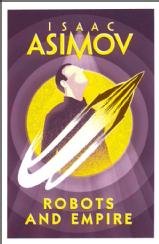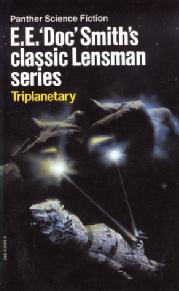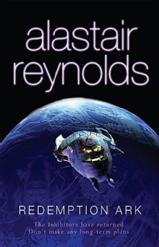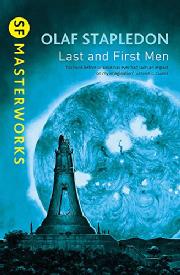Cosmic Histories
Most science fiction tells fundamentally human stories, on human timescales of weeks, months, years, lifetimes or perhaps generations. Certainly television and film science fiction tends to focus on such human timespans. However sometimes science fiction authors venture into the longer timescales on which cosmic evolution itself unfolds, and doing so sheds light into the many ways we as humans engage with visions of the future.
Rise and Fall
A step in this direction can be found in Brian Aldiss’s epic Helliconia trilogy (Helliconia Spring, 1982; Helliconia Summer, 1983; Helliconia Winter, 1985). While each novel concerns itself with a limited time period, perhaps a generation or two, the trilogy traces a complete orbit of the Helliconia binary star - 2592 (Earth) years. This is long enough for civilisations to rise and fall, both on Helliconia itself and on Earth and its proxy, the space station Avernus. Thus the trilogy explicitly juxtaposes the immediate struggles of individuals for survival, dominance and prosperity against the longer cycles and perspectives of cultures or planets.
A similar civilisation-scale timespan is explored in Isaac Asimov’s Robots and Foundation sequence (published in a variety of forms and developments between 1942 and 1986). The original Foundation trilogy was compiled from short stories and published in novel form in 1951-1953. Eventually the series merged with the same author's Robot series (also started in the 1950s) and drew in a number of his originally-standalone earlier works, with retro-continuity novels, mostly written in the 1980s, filling the gaps in the chronology and providing linking material.
 The full sequence begins with robot development in a recognisably near-future Earth society, explores the first wave of human expansion onto other planets, their return to Earth and the advent of a second wave of colonisation, the rise and fall of a long-lived Galactic Empire, and the rise of later civilisations. Two running themes through the sequence are an exploration of psychohistory (the premise that while humans themselves are unpredictable, the future of humanity and human societies as a whole will follow closely-predictable lines), and the idea that near-immortal and self-aware robots given an imperative directive to protect humans may recognise the implicit requirement that humanity itself must be protected and guided, ultimately over a twenty-thousand year timespan. Both themes are played out to their logical extreme, although both remain well beyond the grasp of current knowledge - seventy years and more after they were conceived, we have proven unable either to predict social and economic trends, or to construct true artificial intelligences.
The full sequence begins with robot development in a recognisably near-future Earth society, explores the first wave of human expansion onto other planets, their return to Earth and the advent of a second wave of colonisation, the rise and fall of a long-lived Galactic Empire, and the rise of later civilisations. Two running themes through the sequence are an exploration of psychohistory (the premise that while humans themselves are unpredictable, the future of humanity and human societies as a whole will follow closely-predictable lines), and the idea that near-immortal and self-aware robots given an imperative directive to protect humans may recognise the implicit requirement that humanity itself must be protected and guided, ultimately over a twenty-thousand year timespan. Both themes are played out to their logical extreme, although both remain well beyond the grasp of current knowledge - seventy years and more after they were conceived, we have proven unable either to predict social and economic trends, or to construct true artificial intelligences.
Dawn Wars
Timescales spanning not just thousands of years but millions, or even billions, can be found in other science fiction novels. Amongst the earliest, H G Wells' The Time Machine (1895) projects its time traveller to the Earth of 801,702 AD where he explores a world in which humanity has evolved into two distinct species - a vision inspired by Wells' fears over industrialisation and a growing class inequality widening the social divide. However in the final, less well known, sequence in the book, the time traveller is projected still further forward, to a time when the Earth's rotation had slowed until it always showed the same face to the Sun [1], and then again "in great strides of a thousand years or more, drawn on by the mystery of the Earth’s fate, watching with a strange fascination the sun grow larger and duller in the westward sky, and the life of the old Earth ebb away. At last, more than thirty million years hence, the huge red-hot dome of the sun had come to obscure nearly a tenth part of the darkling heavens."

Another sweeping epic found in science fiction is the Lensman series, written by E E ‘Doc’ Smith (published in novel form 1948-1954, based on stories published 1934-1948). Most of the action in the series covers a span of a few centuries and focusses on humans (and a few sentients from other races) as individuals, but the root of events and a key driver is laid out as a two-billion-year conflict between a “good” race, the Arisians, and an “evil” race, the Eddorians, which is introduced in the first novel in the sequence - Triplanetary. This traces the influence of both ancient races through the fall of Atlantis (in a nuclear apocalypse) and the fall of Rome, as well as the rise of Earth's space-travelling civilisation. Working through specific bloodlines, on Earth and elsewhere, the Arisians sponsor a galactic patrol staffed by “lensmen” - operatives genetically gifted to use a device which gives them telepathic and other psychic powers. While the text is strongly supportive of the Arisians, from a modern perspective their selective breeding project (which aims to develop the ultimate lensmen over the span of thousands of years) is rather tainted by the shadow of eugenics and the ongoing debate over human genetic manipulation and the right to self-determination. In this sequence, too, humanity, for all its strengths, is ultimately a subordinate race - a late-comer to the great cosmic story.
Interestingly, although Triplanetary, like most of Smith’s writing, is rather non-scientific and melodramatic space opera, there are elements of it which reflect the popular perception of scientific knowledge of the time. Perhaps most strikingly, and rather jarringly for a modern audience, the term “computer” is used frequently in its original sense as a human being capable of rapid and complex calculations, rather than as a manufactured device.
The entire scenario also extends from a premise that relatively few habitable planets form in a typical galaxy, making life rare and resulting in the competing duality of powerful ancient races. The formation of Earth and planets elsewhere is described as being the consequence of interaction between our galaxy and another. As Hector MacPherson discussed in an article in Popular Astronomy in 1914, the balance of probabilities at that time was considered to be in favour of abundant life and habitable worlds in the Universe. However, some influential thinkers, such as Alfred Russel Wallace (writing in 1903) supported the idea that the Earth’s orbit around the Sun, and the Sun’s position in the galaxy might be sufficiently unusual to make life here unique. Into the 1930s, authors continued to debate whether planets were common or rare. One influential theory was that a planetary system could only form as a result of material being thrown out by an extremely rare head-on collision between two stars - now known to be far from the usual mechanism. Uncertainty on the frequency of habitable planet formation continues to this day, although the evidence is now strongly in favour of planetary systems being extremely common around main sequence stars. It’s also interesting to note that two billion years ago might still be considered a reasonable guess for when a galaxy like the Milky Way might have first become a reasonable abode of life.
Another interesting example here is the Revelation Space sequence written by Alistair Reynolds (Revelation Space, Redemption Ark, Absolution Gap, 2000-2003; Inhibitor Phase, 2021). While these novels take place over a relatively-limited, human timespan of centuries, like the Lensmen series, it is shaped by events which span far longer periods.
Reynolds was a professional astrophysicist before becoming a professional writer, and cutting-edge scientific understanding comes across in his writing: in particular, two key aspects of the evolution not just of stars but of entire galaxies are instrumental to the plot of his novels. The first involves the fine balance between the generation of heavy elements (metals in astronomical parlance) in stellar cores and the impact that these materials have on the frequency of habitable planets. As the metal production spread from the core of the galaxy to its edges, he envisioned a Dawn War which would result from the earliest sentient civilisations attempting to secure ever scarcer resources. A result of that Dawn War was the development of the Inhibitors - waiting machines which are designed to prevent any civilisation developing interstellar travel, in anticipation of a second resource crisis which will result from a later stage of galactic evolution: the merger between galaxies, and in this case between the Milky Way and Andromeda/M31 which is expected to occur in about 4.5 billion years from today.
 Lengthy passages describe these events, particularly in the second book of the sequence, Redemption Ark:
Lengthy passages describe these events, particularly in the second book of the sequence, Redemption Ark:
"It was from the core zones, within a thousand parsecs of the galactic centre itself, that the first star forming cultures emerged. They looked into the galactic wilderness, flung envoys across thousands of light-years and imagined themselves alone and unique and somehow privileged. It was a time of sadness and chilling cosmic potential. They imagined themselves to be lords of creation.
"But nothing in the galaxy was that straightforward" (Gollancz edition 2008, pg 266)
Such accounts make it clear that the encounter between humanity and inhibitors which drives much of the plot of the books is only part of this much longer cosmic history. Again, humans are shown in all their vitality and creativity, and the urgency of their lives is undiminished, but they are shown to be essentially transient features as seen from the perspective of the Galaxy as a whole.
Human Destiny
 A more central role is given to humanity by Olaf Stapledon in his novel The Last and First Men (1930). Here, again, the time scale is around two billion years, but instead of looking back to the past like Smith, or Reynolds, Stapledon attempts to project the future history of humankind through no fewer than eighteen distinct species, all of which are confined to the Solar System. Not all of these are what might be conventionally considered advancements on the current human form. Stapledon imagines a somewhat cyclic future, with some human species degenerating before other technological and civilised species arise. Stapledon’s ultimate form for humanity, the Eighteenth Men, inhabit Neptune with a sexually-liberal culture boasting multiple genders and are described as a race of philosophers. Facing ultimate destruction as the Sun evolves, they leave a legacy in the form of a virus that will spread life between the stars.
A more central role is given to humanity by Olaf Stapledon in his novel The Last and First Men (1930). Here, again, the time scale is around two billion years, but instead of looking back to the past like Smith, or Reynolds, Stapledon attempts to project the future history of humankind through no fewer than eighteen distinct species, all of which are confined to the Solar System. Not all of these are what might be conventionally considered advancements on the current human form. Stapledon imagines a somewhat cyclic future, with some human species degenerating before other technological and civilised species arise. Stapledon’s ultimate form for humanity, the Eighteenth Men, inhabit Neptune with a sexually-liberal culture boasting multiple genders and are described as a race of philosophers. Facing ultimate destruction as the Sun evolves, they leave a legacy in the form of a virus that will spread life between the stars.
Stapledon evidently had a taste for epic cosmic histories. Unsatisfied with two billion years of humanity, his later novel Star Maker proceeds to tell the entire history of the multiverse, as seen through the perceptions of a human undergoing a form of out of body experience, travelling mentally between the stars, ultimately merging with alien intelligences into a cosmic mind, and encountering the intelligence of a creator deity. Stapledon’s main focus here is philosophical and metaphysical, rather than on character, plot or science. Nonetheless, some attention is paid to the latter subject [2]. Despite being primarily a philosopher, Stapledon wrote a number of poems known as “Astronomical Posters” inspired by popular publications on astronomy in the 1920s and 1930s, and the descriptions of stars, nebulae and planets are based at least in part on the (very limited) general understanding of the time. It’s also clear that Stapledon, like Smith, considered the creation of life-supporting planets likely to be rare - the result of head on collisions between stars rather than a normal part of stellar evolution.
An Exercise in Eschatology
Stapledon’s cosmic histories ended with extinction or an encounter with the divine, but a number of science fiction stories focus on a different ending: the ultimate fate of the Universe. A fascination with end times, or eschatology, can be traced back to ancient religions, and is fundamental to studies of the biblical Book of Revelations. It has not lost any of its interest over time, as witnessed by the success of Dr Katie Mack’s popular account of modern cosmological eschatology: The End of Everything (Astrophysically Speaking) (Mack 2020) - which was named one of the New York Times' notable books of 2020.
Mack's scenarios include a Big Rip and a very sudden quantum vacuum decay which leaves little time or scope for science fiction! However, for much of the twentieth century, the most commonly discussed scientific paradigm for the end of the Universe, was another topic she discusses: the so-called “heat death of the Universe” - the probable fate of a closed Universe in which entropy continuously increases. The dissipation of useful energy sources into chaotic entropy is a feature of the second law of thermodynamics, and defines the arrow of time in the Universe in which we live. As stars burn fuel, their atomic energy store is converted into the disorder of heat, from which energy cannot be recovered without the injection of more energy for processing. Given sufficient time, all of the useful energy in the Universe, including the physical structures of planets, stars and galaxies, would be converted to the random thermal motions of heat, and this would be evenly distributed in the movement of atoms through space. Much of it might be reradiated in the far-infrared, as long wavelength photons with too little energy to excite electrons or otherwise interact with matter. Without a thermal gradient, energy cannot be extracted by any known thermodynamic process. Given that the Universe has been known since the 1930s to be expanding, this does not necessarily imply that the space will actually be “hot” in the conventional sense, since the atoms and photons carrying the thermal energy would themselves be widely scattered in otherwise empty space.
This scenario, and another account of the future evolution of humanity, albeit in less detail, can be found in the memorable Isaac Asimov short story “The Last Question” (1956). Here a series of humans, of ever more-advanced evolutionary status, ask a series of similarly more advanced computers essentially the same question: “Can entropy be reversed?”. It is not until the final evolutions of humanity and computing merge into a single all-encompassing universal consciousness inhabiting an entropy-filled heat-death universe that an answer is decided upon.
Alternate endings for the Universe, of more or less plausibility, can be found in other science fictions. City at the End of Time (Greg Bear, 2008) imagines a last city in a decaying Universe in which the galaxies have burnt out. This universe is being consumed by an entity of destruction in a story which hovers between science fiction and horror. James Blish’s much earlier Cities in Flight series follows the story of various city constructs which abandon a dying Earth, and culminates in A Clash of Cymbals (Blish, 1959). By contrast with the one hundred trillion year timescale of City at the End of Time, and the billions of years in other novels, this example projects the end of the Universe to a relatively-imminent year 4000 AD, and posits a collision between our Universe and another comprised of antimatter. Neither scenario appears terribly likely in light of our current cosmological understanding.
A few novels even attempt to predict what might follow the end. Tau Zero (Poul Anderson, 1970) explores the experiences of the crew of a relativistic starship, whose vessel begins to accelerate ever closer to the speed of light, such that their journey, intended to take just a few decades of Earth time (while the crew experience five years of elapsed time) now extends to the Big Crunch [3] in the dying light of the lowest mass stars at the end of the Universe. While the time dilation effect associated with near-relavistic travel could indeed extend journeys into eon-long experiences relative to Earth, our current paradigm excludes near-light accelerations actually being possible due to their energy requirements. They certainly exclude the possibility that such a ship could survive the end of time and space and emerge unscathed into a new Universe that follows this event - as Anderson hypothesised.
Much of this discussion in science fiction precedes the discovery that the Universe is in fact accelerating its expansion, due to a poorly-understood influence known as dark energy. The result of this is that while energy is indeed being dissipated into heat as entropy increases, the Universe is growing so rapidly that this heat is spread through an ever-larger volume and at an even faster rate than earlier authors expected. Another consequence is that rather than continuing to grow as more distant light reaches us, our observable horizon will eventually shrink to a smaller, and colder, region of space from which most of the heat and matter in the Universe is excluded. Despite this shift in our scientific understanding, the fundamental question of how the evolution of the Universe as a whole will ultimately impact mankind remains, and it is interesting to note the different way authors have explored the ultimately-unknowable fate that lies ahead of us all.
“Cosmic Histories”. Elizabeth Stanway, Cosmic Stories blog, 17th April 2022.
Notes:
[1] We now think that Earth is unlikely to tidally lock to either the Moon or the Sun before the end of the latter's lifetime, but both possibilities were believed to be likely in the nineteenth century. [Return to text]
[2] The motivations and goals of Stapledon in this work, and its precursors in Stapledon’s corpus of work, have been studied extensively with reference to his archives by McCarthy (2004), which provides a source for some of the information here. [Return to text]
[3] The Big Crunch was a hypothesised end-Universe event in which the matter density of the Universe overcame the initial expansion resulting from the Big Bang, reversing it and leading to space contracting into a single point in a mirror of the initial singularity. The measurement of dark energy, and of a low mean matter density, rules out this scenario. [Return to text]
Image source: book covers sourced online under fair use provisions for commentary and criticism.
All opinions in this blog are my own and do not necessarily reflect those of the University of Warwick.
